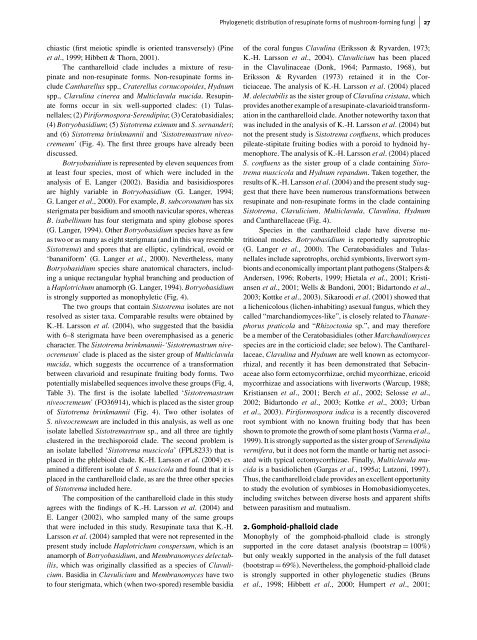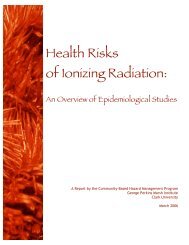The phylogenetic distribution of resupinate forms ... - Clark University
The phylogenetic distribution of resupinate forms ... - Clark University
The phylogenetic distribution of resupinate forms ... - Clark University
Create successful ePaper yourself
Turn your PDF publications into a flip-book with our unique Google optimized e-Paper software.
chiastic (first meiotic spindle is oriented transversely) (Pine<br />
et al., 1999; Hibbett & Thorn, 2001).<br />
<strong>The</strong> cantharelloid clade includes a mixture <strong>of</strong> <strong>resupinate</strong><br />
and non-<strong>resupinate</strong> <strong>forms</strong>. Non-<strong>resupinate</strong> <strong>forms</strong> include<br />
Cantharellus spp., Craterellus cornucopoides, Hydnum<br />
spp., Clavulina cinerea and Multiclavula mucida. Resupinate<br />
<strong>forms</strong> occur in six well-supported clades: (1) Tulasnellales;<br />
(2) Piriformospora-Serendipita; (3) Ceratobasidiales;<br />
(4) Botryobasidium;(5)Sistotrema eximum and S. sernanderi;<br />
and (6) Sistotrema brinkmannii and ‘Sistotremastrum niveocremeum’<br />
(Fig. 4). <strong>The</strong> first three groups have already been<br />
discussed.<br />
Botryobasidium is represented by eleven sequences from<br />
at least four species, most <strong>of</strong> which were included in the<br />
analysis <strong>of</strong> E. Langer (2002). Basidia and basisidiospores<br />
are highly variable in Botryobasidium (G. Langer, 1994;<br />
G. Langer et al., 2000). For example, B. subcoronatum has six<br />
sterigmata per basidium and smooth navicular spores, whereas<br />
B. isabellinum has four sterigmata and spiny globose spores<br />
(G. Langer, 1994). Other Botryobasidium species have as few<br />
as two or as many as eight sterigmata (and in this way resemble<br />
Sistotrema) and spores that are elliptic, cylindrical, ovoid or<br />
‘bananiform’ (G. Langer et al., 2000). Nevertheless, many<br />
Botryobasidium species share anatomical characters, including<br />
a unique rectangular hyphal branching and production <strong>of</strong><br />
a Haplotrichum anamorph (G. Langer, 1994). Botryobasidium<br />
is strongly supported as monophyletic (Fig. 4).<br />
<strong>The</strong> two groups that contain Sistotrema isolates are not<br />
resolved as sister taxa. Comparable results were obtained by<br />
K.-H. Larsson et al. (2004), who suggested that the basidia<br />
with 6–8 sterigmata have been overemphasised as a generic<br />
character. <strong>The</strong> Sistotrema brinkmannii-‘Sistotremastrum niveocremeum’<br />
clade is placed as the sister group <strong>of</strong> Multiclavula<br />
mucida, which suggests the occurrence <strong>of</strong> a transformation<br />
between clavarioid and <strong>resupinate</strong> fruiting body <strong>forms</strong>. Two<br />
potentially mislabelled sequences involve these groups (Fig. 4,<br />
Table 3). <strong>The</strong> first is the isolate labelled ‘Sistotremastrum<br />
niveocremeum’ (FO36914), which is placed as the sister group<br />
<strong>of</strong> Sistotrema brinkmannii (Fig. 4). Two other isolates <strong>of</strong><br />
S. niveocremeum are included in this analysis, as well as one<br />
isolate labelled Sistotremastrum sp., and all three are tightly<br />
clustered in the trechisporoid clade. <strong>The</strong> second problem is<br />
an isolate labelled ‘Sistotrema muscicola’ (FPL8233) that is<br />
placed in the phlebioid clade. K.-H. Larsson et al. (2004) examined<br />
a different isolate <strong>of</strong> S. muscicola and found that it is<br />
placed in the cantharelloid clade, as are the three other species<br />
<strong>of</strong> Sistotrema included here.<br />
<strong>The</strong> composition <strong>of</strong> the cantharelloid clade in this study<br />
agrees with the findings <strong>of</strong> K.-H. Larsson et al. (2004) and<br />
E. Langer (2002), who sampled many <strong>of</strong> the same groups<br />
that were included in this study. Resupinate taxa that K.-H.<br />
Larsson et al. (2004) sampled that were not represented in the<br />
present study include Haplotrichum conspersum, which is an<br />
anamorph <strong>of</strong> Botryobasidium,andMembranomyces delectabilis,<br />
which was originally classified as a species <strong>of</strong> Clavulicium.<br />
Basidia in Clavulicium and Membranomyces have two<br />
to four sterigmata, which (when two-spored) resemble basidia<br />
Phylogenetic <strong>distribution</strong> <strong>of</strong> <strong>resupinate</strong> <strong>forms</strong> <strong>of</strong> mushroom-forming fungi 27<br />
<strong>of</strong> the coral fungus Clavulina (Eriksson & Ryvarden, 1973;<br />
K.-H. Larsson et al., 2004). Clavulicium has been placed<br />
in the Clavulinaceae (Donk, 1964; Parmasto, 1968), but<br />
Eriksson & Ryvarden (1973) retained it in the Corticiaceae.<br />
<strong>The</strong> analysis <strong>of</strong> K.-H. Larsson et al. (2004) placed<br />
M. delectabilis as the sister group <strong>of</strong> Clavulina cristata,which<br />
provides another example <strong>of</strong> a <strong>resupinate</strong>-clavarioid transformation<br />
in the cantharelloid clade. Another noteworthy taxon that<br />
was included in the analysis <strong>of</strong> K.-H. Larsson et al. (2004) but<br />
not the present study is Sistotrema confluens, which produces<br />
pileate-stipitate fruiting bodies with a poroid to hydnoid hymenophore.<br />
<strong>The</strong> analysis <strong>of</strong> K.-H. Larsson et al. (2004) placed<br />
S. confluens as the sister group <strong>of</strong> a clade containing Sistotrema<br />
muscicola and Hydnum repandum. Taken together, the<br />
results <strong>of</strong> K.-H. Larsson et al. (2004) and the present study suggest<br />
that there have been numerous transformations between<br />
<strong>resupinate</strong> and non-<strong>resupinate</strong> <strong>forms</strong> in the clade containing<br />
Sistotrema, Clavulicium, Multiclavula, Clavulina, Hydnum<br />
and Cantharellaceae (Fig. 4).<br />
Species in the cantharelloid clade have diverse nutritional<br />
modes. Botryobasidium is reportedly saprotrophic<br />
(G. Langer et al., 2000). <strong>The</strong> Ceratobasidiales and Tulasnellales<br />
include saprotrophs, orchid symbionts, liverwort symbionts<br />
and economically important plant pathogens (Stalpers &<br />
Andersen, 1996; Roberts, 1999; Hietala et al., 2001; Kristiansen<br />
et al., 2001; Wells & Bandoni, 2001; Bidartondo et al.,<br />
2003; Kottke et al., 2003). Sikaroodi et al. (2001) showed that<br />
a lichenicolous (lichen-inhabiting) asexual fungus, which they<br />
called “marchandiomyces-like”, is closely related to Thanatephorus<br />
praticola and “Rhizoctonia sp.”, and may therefore<br />
be a member <strong>of</strong> the Ceratobasidiales (other Marchandiomyces<br />
species are in the corticioid clade; see below). <strong>The</strong> Cantharellaceae,<br />
Clavulina and Hydnum are well known as ectomycorrhizal,<br />
and recently it has been demonstrated that Sebacinaceae<br />
also form ectomycorrhizae, orchid mycorrhizae, ericoid<br />
mycorrhizae and associations with liverworts (Warcup, 1988;<br />
Kristiansen et al., 2001; Berch et al., 2002; Selosse et al.,<br />
2002; Bidartondo et al., 2003; Kottke et al., 2003; Urban<br />
et al., 2003). Piriformospora indica is a recently discovered<br />
root symbiont with no known fruiting body that has been<br />
shown to promote the growth <strong>of</strong> some plant hosts (Varma et al.,<br />
1999). It is strongly supported as the sister group <strong>of</strong> Serendipita<br />
vermifera, but it does not form the mantle or hartig net associated<br />
with typical ectomycorrhizae. Finally, Multiclavula mucida<br />
is a basidiolichen (Gargas et al., 1995a; Lutzoni, 1997).<br />
Thus, the cantharelloid clade provides an excellent opportunity<br />
to study the evolution <strong>of</strong> symbioses in Homobasidiomycetes,<br />
including switches between diverse hosts and apparent shifts<br />
between parasitism and mutualism.<br />
2. Gomphoid-phalloid clade<br />
Monophyly <strong>of</strong> the gomphoid-phalloid clade is strongly<br />
supported in the core dataset analysis (bootstrap = 100%)<br />
but only weakly supported in the analysis <strong>of</strong> the full dataset<br />
(bootstrap = 69%). Nevertheless, the gomphoid-phalloid clade<br />
is strongly supported in other <strong>phylogenetic</strong> studies (Bruns<br />
et al., 1998; Hibbett et al., 2000; Humpert et al., 2001;
















